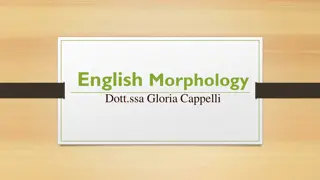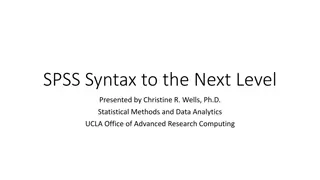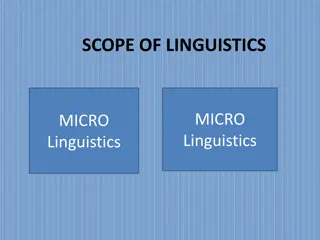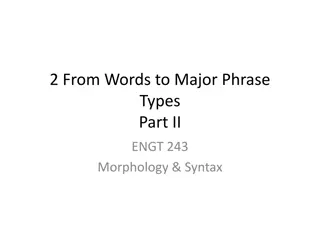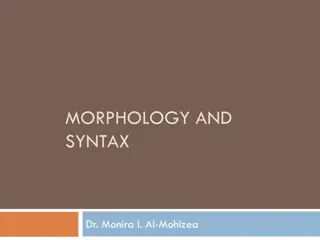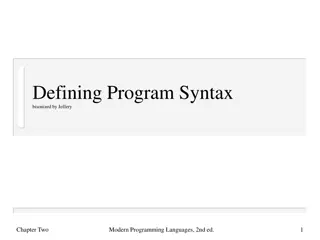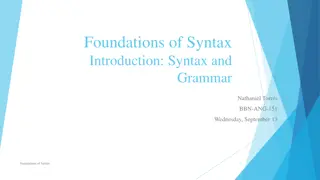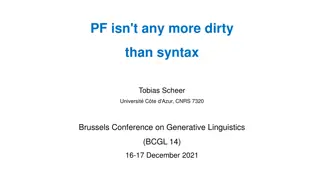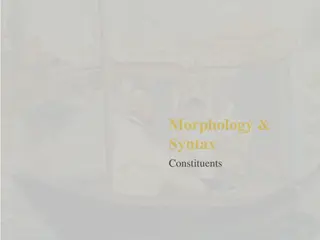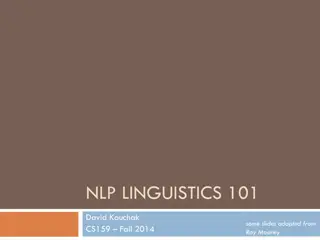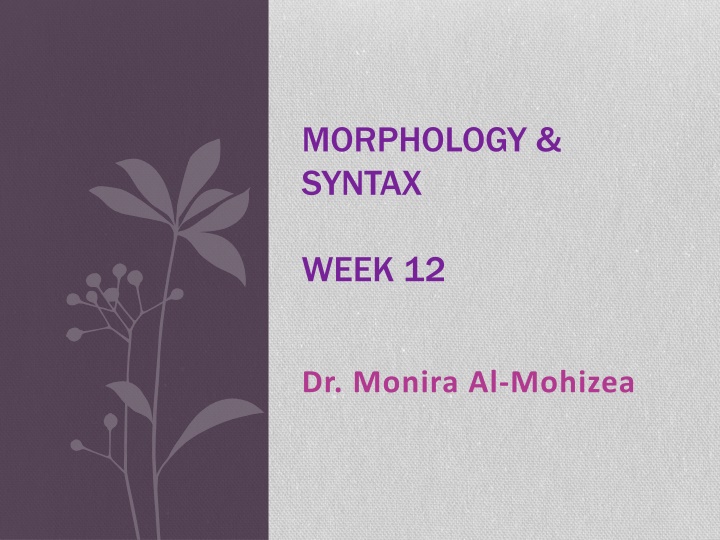
Prototype Theory and Word Classes in Morphology and Syntax
Explore how Prototype Theory influences the categorization of nouns and verbs in grammar, with examples of typical versus atypical word classes. Compare the frequency of nouns and pronouns in written and spoken language contexts.
Download Presentation

Please find below an Image/Link to download the presentation.
The content on the website is provided AS IS for your information and personal use only. It may not be sold, licensed, or shared on other websites without obtaining consent from the author. If you encounter any issues during the download, it is possible that the publisher has removed the file from their server.
You are allowed to download the files provided on this website for personal or commercial use, subject to the condition that they are used lawfully. All files are the property of their respective owners.
The content on the website is provided AS IS for your information and personal use only. It may not be sold, licensed, or shared on other websites without obtaining consent from the author.
E N D
Presentation Transcript
MORPHOLOGY & SYNTAX WEEK 12 Dr. Monira Al-Mohizea
Prototype theory Prototype theory Prototype Prototype theory was developed by theory was developed by Eleanor The The same idea of prototype categories with same idea of prototype categories with degrees membership applies to membership applies to grammar grammar, , just as some birds are birdy birdy than others, so some than others, so some nouns, verbs are less less verby verby than others. than others. The typical nouns are those referring to The typical nouns are those referring to people, animal, things. And among these are those which children learn first. And among these are those which children learn first. The typical The typical verb is a verb is a doing word . doing word . E.g. walk, eat. Therefore, when defining grammatical terms, we use Therefore, when defining grammatical terms, we use typical typical or or general general to indicate that there are to indicate that there are fuzzy boundaries boundaries of grammatical classes especially in relation to of grammatical classes especially in relation to meaning meaning. . Discuss examples of Discuss examples of typical typical vs. plurals vs.?? plurals vs.?? Eleanor Rosch Rosch in 1970s. in 1970s. degrees of of just as some birds are less nouns, verbs are less less or less nouny nouny or people, animal, things. E.g. walk, eat. fuzzy vs. less typical less typical noun. noun.
Conclusion.. Conclusion.. Grammar is not a Grammar is not a precise system. system. It has much in common with systems or organisms in It has much in common with systems or organisms in real life real life- - in the sense that it involves in the sense that it involves typical atypical atypical membership. membership. precise logical logical or mathematical or mathematical typical vs. vs.
Word classes and frequency Word classes and frequency C Comparing omparing nouns and nouns and pronouns: pronouns: Type: Type: is a unique form of a is a unique form of a word word (e.g. If If we count the we count the tokens tokens (i.e. individual (i.e. individual instances) of texts, we find texts, we find that that the use of word classes the use of word classes varies In general, then, content word classes have become more frequent, In general, then, content word classes have become more frequent, and function words less frequent. and function words less frequent. The most notable The most notable difference is in difference is in nouns very common in very common in typical typical written texts written texts - - especially in newspapers while pronouns are very while pronouns are very common, in common, in speech. Here are typical examples from a written text and a spoken dialogue. The aviation and casino kingpin Kirk Kekorian finally sold MGM film entertainment division to Path boss Gincarlo Parretti inNovembr ) I think you'll find it counts towards your income. (e.g. v+ed v+ed pattern) pattern) instances) of word classes in word classes in varies greatly in greatly in frequency. frequency. nouns and especially in newspapers - - speech. and pronouns pronouns: nouns are : nouns are
Compound Compound- -complex sentence complex sentence A A compound compound- -complex complex sentence: sentence: is a sentence consists consists of: of: two two or more or more independent clauses (main independent clauses (main clauses) and at least clauses) and at least one one dependent (subordinate clause) clause). . Example: Example: C Consider?? onsider?? Although Although she worked hard to gain she worked hard to gain recognition, people did not know who she was, and her friends did people did not know who she was, and her friends did not even appreciate her work. not even appreciate her work. is a sentence dependent (subordinate recognition, many many
Solution.. Solution.. Although she worked hard to gain Although she worked hard to gain recognition (dependent clause) (dependent clause), , many many people did not know who she people did not know who she was (independent clause) (independent clause), , and and (coordinating conjunction) (coordinating conjunction) her her friends did not even appreciate her friends did not even appreciate her work (independent clause) (independent clause). . recognition was work
GRAMMATICAL RELATIONS GRAMMATICAL RELATIONS W We e have looked at the types of sentences based on the have looked at the types of sentences based on the usage usage, , form form, and , and structure structure. . Now Now we will focus on the internal structure of sentence, we will focus on the internal structure of sentence, involving the involving the grammatical relations grammatical relations ( (syntactic functions functions) ) Commonly, the basic pattern of the simple English Commonly, the basic pattern of the simple English sentence is: sentence is: ( (Adjunct) + (Subject) + Adjunct) + (Subject) + Predicate Predicate + (Object) + (Complement) + (Adjunct) (Complement) + (Adjunct) ( (A) (S) A) (S) P P (O) (C) (A) where only the Predicate (P) is (O) (C) (A) where only the Predicate (P) is essential, and in which the essential, and in which the Adjunct syntactic + (Object) + Adjunct (A) is mobile. (A) is mobile.
NOTE: NOTE: A noun (person or thing) which performs the A noun (person or thing) which performs the action of a verb, or which Subject is joined to a action of a verb, or which Subject is joined to a description by a verb description by a verb. . (S) A part of sentence or clause containing a verb (S) A part of sentence or clause containing a verb and stating something Predicate about the subject. and stating something Predicate about the subject. (P) Object A noun (person or thing) that is affected by (P) Object A noun (person or thing) that is affected by the action of a verb or (O) involved in the result of an the action of a verb or (O) involved in the result of an action that is done by a subject. Adjunct A word used action that is done by a subject. Adjunct A word used as modifier in a sentence. (A)Complement A word or as modifier in a sentence. (A)Complement A word or word group that completes the predicate in a word group that completes the predicate in a sentence. (C) sentence. (C)
Example, consider ? Example, consider ? The man called the boy suddenly. The man called the boy suddenly. ( (Noun Part) Noun Part) ? ? ( (Verb Part) Verb Part) ? ? ( (Noun Part) Noun Part) ? ? ( (Adverb Part Adverb Part) ? ) ? Think in terms of (S P O A) pattern Think in terms of (S P O A) pattern
A complement A complement Complement Complement (C (C) is linking verbs linking verbs (e.g. LOOK, TASTE, SMELL, SOUND, FEEL, etc.) to complete the predicate in a predicate in a sentence. E.g., sentence. E.g., She As the name suggests, a complement is something that a complement is something that completes something. completes something. Examples: Examples: She She becomes becomes a doctor a doctor. . He He was was in the bus in the bus. . Your Your perfume smells perfume smells very good very good. . Before Before the show, she seemed the show, she seemed nervous Thus Thus, beautiful, a doctor, in the bus, very good, and nervous , beautiful, a doctor, in the bus, very good, and nervous are complements are complements. . ) is word or a group of words that involve word or a group of words that involve (e.g. APPEAR, BECOME, , BE, SEEM, GROW, , etc.) to complete the She is is beautiful beautiful. . nervous. .
Types of Complements Types of Complements (1) (1) Subject complement Subject complement: is the complement that provides information about the subject E.g. He was in the bus. S P C ( in the bus provides the information about the subject he). (2) (2) Object complement Object complement: is the complement that provides information on the object, E.g. (1) The man called his brother a fool. S P O C ( a fool provides the information about the object his brother) (2) Susan found the assignment difficult. S P O C ( difficult provides the information about the object assignment)
Example Example Example of the complete basic pattern of simple Example of the complete basic pattern of simple English sentence English sentence: : John John often often called called his brother his brother a a fool. fool. S S A A P O P O C C
Sentence Sentence p patterns There are There are four four kind of operations that can be kind of operations that can be used to examine a sentence variation without used to examine a sentence variation without changing its semantic changing its semantic aspect: 1) 1) Insertion Insertion (Addition) (Addition) 2) 2) Deletion Deletion 3) 3) Substitution Substitution 4) 4) Transposition Transposition (Permutation) (Permutation) atterns aspect:
Insertion Insertion & deletion & deletion 1. 1. Insertion Insertion (Addition (Addition) ): : is more constituents inside a more constituents inside a sentence. Example Example: : The The boy is clever. The boy is clever. The handsome handsome( (insertion1) insertion1) boy is 2. 2. Deletion: Deletion: is the process of removing one is the process of removing one or constituents of a sentence. constituents of a sentence. Example Example: : The The handsome handsome boy is boy is very is the process of putting one or the process of putting one or sentence. boy is very very( (insertion2) insertion2) clever. or more clever. more very clever. The boy is clever. clever. The boy is clever.
Substitution & Transposition Substitution & Transposition 3. 3. Substitution: Substitution: is the process of substituting both is the process of substituting both subject object object into pronouns, or verb phrases into auxiliary verbs. into pronouns, or verb phrases into auxiliary verbs. Examples Examples: : The young man The young man visited visited visited her her. . 4 4. . Transposition Transposition (Permutation (Permutation): ): is the position or the order of constituents in a sentence the position or the order of constituents in a sentence without changing the grammatical and semantic aspects. without changing the grammatical and semantic aspects. Examples: Examples: 1. 1. The The man man called called the boy the boy suddenly suddenly. S P O A 2. 2. The The man man suddenly suddenly called called the 3. 3. Suddenly Suddenly the man the man called called the boy subject or or visited her mother her mother He He is the process of exchanging the process of exchanging . S P O A boy. S A P O S A P O the boy. A S P O . A S P O the boy.
GRAMMATICAL vs. GRAMMATICAL vs. UNGRAMMATICAL In English and in every language, every sentence is a In English and in every language, every sentence is a sequence of words, but sequence of words, but not not every sequence of words is a sentence. a sentence. Sequences Sequences of words that conform to the rules of syntax of words that conform to the rules of syntax are are grammatical grammatical , and those that violate the syntactic , and those that violate the syntactic rules are called rules are called ungrammatica ungrammatical l . U Utterances tterances ( (spoken spoken sentences sentences) which are constructed appropriately based on grammatical rules are normally appropriately based on grammatical rules are normally called called grammatical sentences grammatical sentences ; while utterances which are not constructed based on the grammatical which are not constructed based on the grammatical rules are called rules are called ungrammatical sentences ungrammatical sentences . UNGRAMMATICAL every sequence of words is . ) which are constructed ; while utterances .
Example Example In linguistics, an ungrammatical sentence is normally In linguistics, an ungrammatical sentence is normally marked with an asterisk ( marked with an asterisk (* *) ) sometimes two in front of it. of it. Example Example: : a a) The ) The mother kissed mother kissed the girl. (grammatical) the girl. (grammatical) b b) ) * *The The mother kissing mother kissing the girl. (ungrammatical) the girl. (ungrammatical) sometimes two in front
GRAMMATICAL & ACCEPTABLE GRAMMATICAL & ACCEPTABLE As As grammatical grammatical refers to the condition in refers to the condition in which the utterance is constructed which the utterance is constructed appropriately based on grammatical rules appropriately based on grammatical rules, , Acceptable Acceptable is used to decide whether or not is used to decide whether or not an utterance (sentence) can be accepted in an utterance (sentence) can be accepted in case of form or the effectiveness of the case of form or the effectiveness of the sentence. sentence.
Consider.. Consider.. The man hit the dog. The man hit the dog. (grammatical The The dog chased the cat. dog chased the cat. (grammatical The cat died. The cat died. (grammatical (grammatical- -acceptable) Based on the structure, we can combine the three Based on the structure, we can combine the three sentences as follow: sentences as follow: The cat that the dog that the man hit chased died. The cat that the dog that the man hit chased died. (grammatical (grammatical- -unacceptable) Most native speakers would not accept the sentence Most native speakers would not accept the sentence above. It is certainly above. It is certainly grammatical grammatical in that all we have done is add one adjective clause is add one adjective clause that the man hit that the man hit that describes the dog describes the dog. . However However, the , the consecutive serial consecutive serial verbs (hit make the make the sentence unacceptable. sentence unacceptable. (grammatical- -acceptable (grammatical- -acceptable acceptable) acceptable) ) acceptable) ) unacceptable) in that all we have done that verbs (hit- -chased chased- -died) died)
When they are embedded within a sentence, most When they are embedded within a sentence, most people cannot accept people cannot accept more than two adjective more than two adjective clauses However, as soon as the adjective clauses occur at the However, as soon as the adjective clauses occur at the end of the sentence, we can accept any number of end of the sentence, we can accept any number of them. them. Thus Thus, the previous sentence will be both , the previous sentence will be both grammatical and and acceptable acceptable in in this structure: this structure: This This is the man that hit the dog that chased the is the man that hit the dog that chased the cat that died. cat that died. ( (grammatical grammatical- -acceptable) clauses. . grammatical acceptable)
AMBIGUOUS & INTERPRETABLE AMBIGUOUS & INTERPRETABLE When When a word or phrase has more than one possible a word or phrase has more than one possible meaning and may cause confusion, meaning and may cause confusion, this lexical ambiguity lexical ambiguity . . T This his is a common feature of English and of many is a common feature of English and of many other languages. other languages. Example Example: : CHIP (Lexical Ambiguous) can be: CHIP (Lexical Ambiguous) can be: this is called is called a a small piece of small piece of wood a long thin piece of potato a a small piece of small piece of silicon wood silicon
Syntactic Syntactic ambiguity ambiguity T There here is is syntactic ambiguity syntactic ambiguity where a capable of more than one interpretation. capable of more than one interpretation. Example Example: : { {Visiting Visiting relatives can cause relatives can cause problems} This This sentence is sentence is ambiguous ambiguous because it can be interpreted as: interpreted as: 1. Relatives 1. Relatives who visit us can cause problems. who visit us can cause problems. where a structure structure is is problems} because it can be OR OR 2 2. When we visit relatives, there can be problems. . When we visit relatives, there can be problems.


